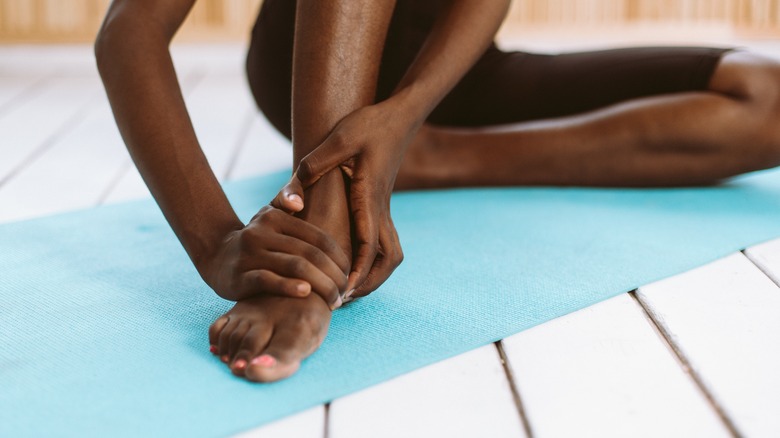What To Do If You Experience Foot Cramps Doing Yoga
A good yoga class can do wonders for the body. You feel your body and mind melt into one during pigeon pose when PING! You get a cramp in your foot. Rather than disrupt the people around you by screaming "Ow! Cramp," there are a few things you can do to ease it.
According to Mayo Clinic, a cramp will occur if one of your muscles suddenly contracts, usually without much warning. The sharp pain typically occurs if the muscles are overused, strained, or held for a long time. You could also experience cramps if you're dehydrated, which might explain why you could get them during a hot yoga class.
If you're in a kneeling or seated pose, come out of the pose and flex your foot (via AZ Central). Massage the foot if the cramp doesn't subside. If you're in a standing pose, bring the cramped foot flat on the floor. While spreading your toes, lift your heel. Press your toes into your mat until the cramp goes away. It also helps to pedal the feet in downward-facing dog pose.
Preventing foot cramps
If you're prone to foot cramps–or any cramps–during yoga, there are a few things you can do outside of class to help. WebMD suggests drinking water throughout the day, especially when you know the weather (or the yoga studio) is either hot or dry. Alcohol also dehydrates you, so avoid it as much as possible if you're cramping more often. A healthy diet rich in calcium, magnesium, and potassium will also help ward off foot cramps. You might also check your medications since some might cause muscle cramps.
Although it might seem silly to stretch outside of yoga class, your arches and the tops of your feet could use some extra stretching throughout the day to prevent cramps (via AZ Central). You can strengthen weak arches by balancing on your toes while doing dishes. Sitting in virasana (hero pose) can stretch the top of your feet. Sit on a cushion between your feet with your shins and the tops of your feet parallel to the floor. Massage your arches with your thumbs for about a minute.
If cramping seems to be occurring frequently, check with your doctor to see if you have low levels of potassium, calcium, or magnesium (via Healthline). A blood and a urine test can determine if you have hypokalemia, which is chronic low potassium.


